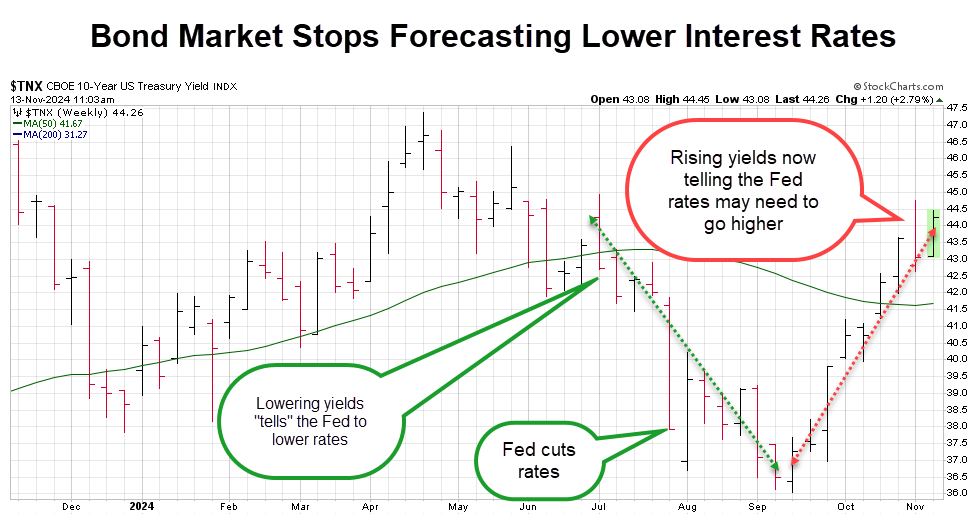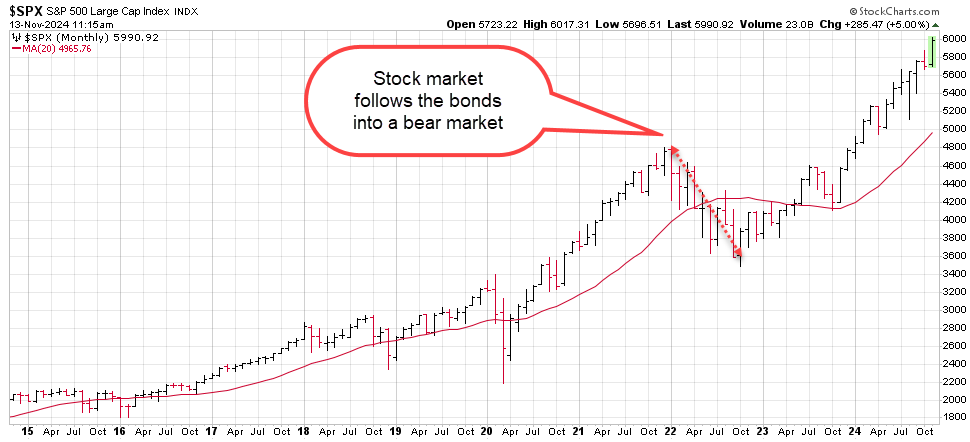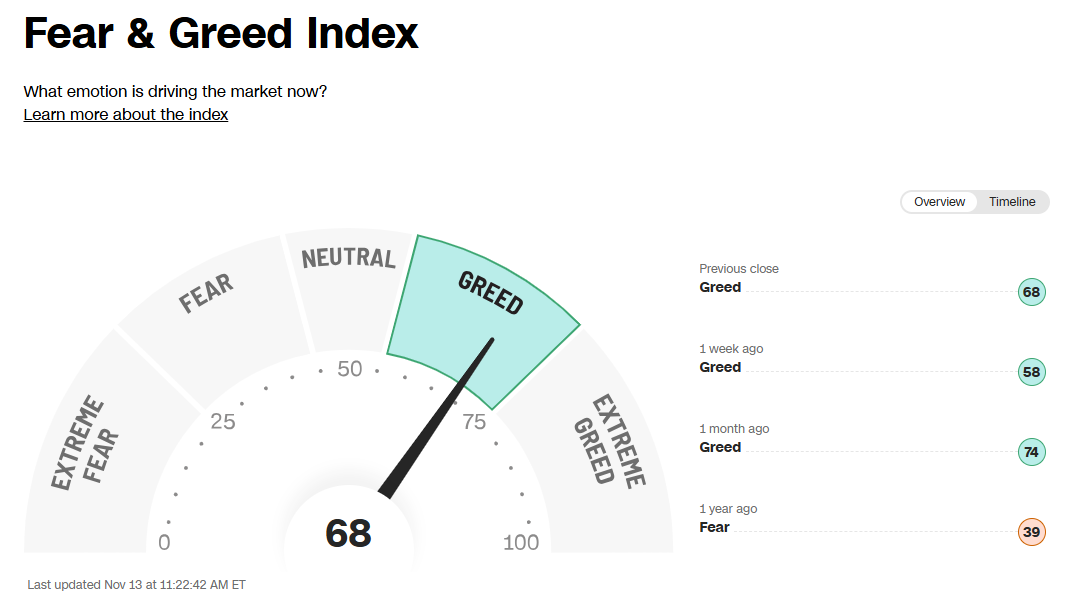This morning’s inflation data came in “as expected” and you could hear stock investors breathing a heavy sigh of relief.
Within minutes, everyone turned their attention back to the S&P 500 moving to its new all-time highs along with NVIDIA climbing higher into next week’s earnings report like nothing happened.
But there’s a smaller group of investors that control a whole lot more money that are still on the edge and planning for a situation that most investors aren’t even considering.
Everyone, and I do mean everyone, should be listening to what the bond market is screaming and then start making appropriate plans for their portfolios.
Let’s go through the situation and a few easy “plans” that could help save your portfolio’s returns.
Bond Market Basics
Bonds are bigger, at least the market is bigger.
The bond market can significantly influence the stock market due to its impact on interest rates and investor sentiment.
When bond yields rise, indicating higher returns on bonds, investors historically shift their funds from stocks to bonds, seeking safer returns. This can lead to a decline in stock prices.
Conversely, lower bond yields might make stocks more attractive due to their potential for higher returns, boosting the amount of money moving into stocks which results in higher prices.
Additionally – and this is extremely important – bond market trends can affect economic expectations.
Rising yields may signal inflation or strong economic growth, while falling yields might indicate economic slowdowns, influencing corporate earnings and stock market performance.
The Bond Market is Forecasting the Return of Inflation
You can almost pinpoint the day that the Bond market determined that the Fed was going to have another battle with inflation brewing.
September 17, the yield on the 10-year Treasuries hit its lows for the year.
Yields had been moving lower, signaling that the Fed was winning their fight against inflation. That also signaled that the Central Bank would continue lowering interest rates into 2025.
But things changed.
 Yields suddenly reversed course and started heading higher, and they haven’t stopped. Today, yields are at their highest since July 2024. At that time, rates were on the decline. That decline in rates ultimately led to the Fed lowering interest rates in September, followed by another cut just last week.
Yields suddenly reversed course and started heading higher, and they haven’t stopped. Today, yields are at their highest since July 2024. At that time, rates were on the decline. That decline in rates ultimately led to the Fed lowering interest rates in September, followed by another cut just last week.
Now, with rates on the rise, the Fed is starting to look like they may slow their easing policy.
With one rate cut penciled in for December, the Fed appears to be preparing for a wait-and-see situation in 2025 as they prepare for the return of inflation.
The Return of Inflation Would Deal a Crushing Blow to Stocks
I don’t have to go through the details, you’ve been there within the last three years.
Three of the six major drivers of inflation are ready to cut the Fed’s easing cycle short.
Lower interest rates: While rates have only dropped 0.75% we’ve already seen consumer confidence and activity take off. Consumers spent so much time waiting for rates to come down that they’ve jumped at the chance to spend again. That’s inflationary.
Government spending: The Government debt market grew 58% last year as spending continues to grow. While the Republicans want to cut spending its not happening. Not only are we slated to see more spending in 2025, interest on servicing existing debt is increasing to add to the pressure.
Proposed Lower Taxes: While nice for those that receive them, lower taxes mean lower tax receipts. The potential for tariffs to be levied on imports could begin to fill that void, in a twist, that is somewhat akin to increasing taxes.
 What the Market is Saying
What the Market is Saying
Bonds have already slipped back into a long-term bear market trend.
Prices of the iShares 20+ Year Treasury Bond ETF (TLT) just moved back below their 20-month moving average. This indicates that the bond market is likely to move lower, which has several consequences.
The last time that the TLT shares moved into a strong bear market trend was January 2022.
At that time, the bond market was reacting to the rise of inflation while projecting that the Fed would need to increase interest rates. The breakdown in bonds was a strong signal that trouble was on the horizon.
As a kicker, the stock market was trading at its all-time highs as investor sentiment had become euphoric and “frothy”.
 The combination of overly optimistic sentiment towards stocks and the break in the bond market were spot-on.
The combination of overly optimistic sentiment towards stocks and the break in the bond market were spot-on.
Bonds dropped 35% over the next year, pulling the S&P 500 25% lower over an eight-month period.
They say that history doesn’t repeat itself but it rhymes. Things are sounding similar now.
 What Investors Should Watch
What Investors Should Watch
The bond market is the dog that wags the “tail” (the stock market).
As boring as it seems, the excitement in the stock market starts with moves in the bond market. For that reason, every investors should be aware of what is happening with bonds.
Remember, the bond market was spot-on in forecasting the Fed’s rate cuts in September. The developing trend in the bond market is suggesting that the Fed is likely to take a pause to read the economic winds.
Any sign of inflation over the next few months will set forth a domino effect. The bond market will slide further into its bearish trend triggering a “correction” in stocks.
Keep in mind that investors, both professional and retail, have been plowing money into the market with the expectations that interest rates were heading to 2% or lower. Jerome Powell may find it necessary to take that target away, a move that will result in immediate changes to valuations of stocks.
A change in the valuation for stocks as investors are in “greed mode” would be painful.
 What Happens from Here
What Happens from Here
Expect to see the market try to follow its seasonally move higher.
Stocks have a strong bullish bias after an election, regardless of which party wins. This combines with the seasonal strength of the November through January months for the market. This is one of the reasons that the market has been experiencing a strong move since the election.
December’s Fed decision will be key.
The Fed is set for their next interest rate decision on December 18. That will be followed by Jerome Powell’s press conference. The presser will be the big event here.
Currently, the market is expecting, no, demanding a 0.25% cut in the Fed Funds rate. Investors have already started backing off their expectations for an additional cut in January.
Any mention of inflation and the need for the Fed to be more flexible in their policy will send investors to the exit.
Easy Steps to Prepare for Renewed Volatility
First, as always, have a plan.
Investors make their biggest mistakes when they don’t plan for an outcome. Right now, “greed” is the plan which means that investors aren’t paying attention to the peripherals like what bond traders are forecasting.
Need to feel more comfortable with having a bearish outlook? Just look at Warren Buffett.
Warren Buffett’s Berkshire Hathaway has been raising cash for most of 2024. Interestingly, investors and the media aren’t talking about it beyond a slight mention here and there. That’s because investors have their “greed glasses” on.
Follow Buffet’s lead. Review your portfolio and start drawing “lines in the sand” (A.K.A. limit orders) where you would like to sell profitable positions to lock in gains. This raises cash in your portfolio to take advantage of buying opportunities that come because of a market correction.
Finally, start “shopping” for portfolio “insurance”.
“Hedging” the market is often seen as a strategy for professionals only, it’s not.
Retail investors have several ways to hedge market volatility and corrections.
- The use of stop-limit or trailing stop-limit orders mentioned above. The use of this simple strategy allows you to take the emotions out of selling an investment for a profit when things start to get crazy.
- Inverse ETFs: These simple-to-use investments allow you to add a position to your portfolio that will increase in value as the market goes down. There are several inverse ETFs available that track indexes like the S&P 500, Nasdaq 100 and Russell 2000.
- Put Options: Consider learning about how to use put options to hedge your portfolio. It’s much simpler than most investors think to hedge like a pro with options as long as you form a plan.
— Chris Johnson
Out of 23,281 Stocks... Only ONE is This Profitable and Undervalued. [sponsor]$3 billion+ in operating income. Market cap under $8 billion. 15% revenue growth. 20% dividend growth. No other American stock but ONE can meet these criteria... here's why Donald Trump publicly backed it on Truth Social. See His Breakdown of the Seven Stocks You Should Own Here.
Source: Money Morning
